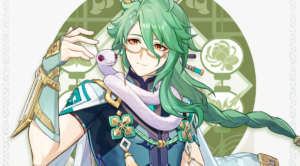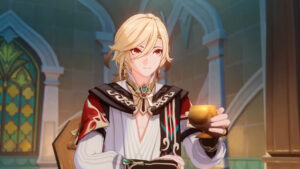It’s been almost two years since the release of Sumeru in Genshin Impact Version 3.0, two years since the last time that Genshin faced a sizable backlash from players over the pervasive issue of racism and colorism in the game’s character design, two years during which the developers have been hard at work on Natlan, the Nation of War, set to release about a month from now in Version 5.0 – and in those two years, Genshin Impact has not gotten better in this regard…if possible, it’s actually gotten worse somehow. Because while there is no one in Natlan (yet) with a design as blatantly offensive as Sumeru’s Dori, for which I suppose I should be grateful, there is also no one whose design bears out the idea, put forward by the music, environment design, architecture, and the characters’ names, that this region is inspired by the cultures and mythologies of pre-colonial North, Central, and South America, Polynesia, and West Africa.

Is this exactly shocking, after the Sumeru debacle? Well, no. To be honest, my expectations for Natlan were already extremely low, and had been ever since Sumeru. But I was still holding out hope that something would have changed, and I can’t help but be disappointed to learn that HoYoverse doesn’t care how many surveys you send back with complaints about the game’s lack of diversity in skin-tones, or about viral tweets and petitions. They make too much money off of Genshin as it stands for them to have to care, and unless players stop spending exorbitant amounts of money on this game every month to get six copies of every new character and five copies of their signature weapon, frankly, change isn’t happening. If Genshin can get away with not including Black and brown playable characters in a region inspired by majority Black and brown cultures, they’re not going to suddenly start in the next region, Shezhnaya, inspired by Tzarist Russia.
Some context on Natlan: it’s the sixth region players will visit on their journey across the world of Teyvat, after Mondstadt (probably still the region with the least culture, but just enough to tell that it’s supposed to evoke Germany, anytime between the Renaissance to the 1800’s), Liyue (rooted in a rich and beautiful depiction of late Qing Dynasty China, with subareas representing various Chinese subcultures; no surprise there, seeing as Genshin Impact is a Chinese game), Inazuma (unmistakably inspired by Meiji Restoration-era Japan, with specific islands aligning closely to Hokkaido and Okinawa), Sumeru (a messy assortment of disparate cultural references, from Algeria through ancient Egypt and Abbasid-era Iraq all the way to Iran and India), and Fontaine (grounded in 18th to 19th Century France, but built on the ruins of an older, Celtic civilization and a Roman Atlantis). Four of the five regions in the game to date are based in a pretty specific period of time in one specific real-world region’s history (and Shezhnaya, as mentioned, seems likely to continue that trend). Sumeru and now Natlan are the odd ones out. No bonus points for guessing what else they have in common.
With Natlan, the vibe Genshin seems to have been going for is “what if all the Indigenous peoples in the Global South had formed an intercontinental, pre-colonial utopia…with dragons”, which is an intriguing premise, even if Genshin‘s writers probably aren’t the best people to pull it off. But somewhere along the line, and maybe I’m naive for believing it was relatively late in the development process because of how the character designs all look so much more cohesive with darker skin, as though the colors of their clothes and hair were deliberately chosen to complement darker skin-tones, I have no doubt that someone higher-up demanded that the characters’ skin be lightened…a little more….and then a little more…until what was meant to be a pre-colonial utopia came out looking distinctly post-colonial in the final product because almost everyone was now white.
I’m not absolving the character designers themselves of all fault, however, because I have issues with the playable cast of Natlan that go beyond their skin-tones and are baked into their designs at a fundamental level. To start with, all of Genshin Impact‘s 84 playable characters (95 if we include the eleven revealed in the Natlan teaser trailer) use one of just five basic models (tall female/male; short female/male; and child-height female) with hardly any variation in facial features apart from eye color and the occasional mole or marking. Natlan didn’t need to break the mold to still do a good job, but it’s a missed opportunity to give characters body-types, facial features, and hair textures that diverge from the Eurocentric beauty standards that Genshin‘s characters currently adhere to almost by default.

But while that would have been a nice touch, it was not nearly as imperative as simply getting the designs right. Clothes, accessories, and hairstyles make up each character’s distinctive and highly individual silhouette, allowing you to identify each character’s cultural background at a glance. Fantastical elements are to be expected in a fantasy game – there are characters with animal ears, antlers, wings, and tails, sometimes multiple tails – but most of these characters are based in the mythological creatures or native wildlife of their home region’s real-world equivalent. Ganyu, from Liyue, is part-Qilin, a horned beast in Chinese folklore. Gorou, from Inazuma, has the ears and tail of a Shiba Inu, a Japanese dog breed. And their outfits, apart from being a bit more revealing than historical clothing, are still very clearly Chinese and Japanese, respectively. The same largely holds true for Mondstadt and Fontaine.
Genshin Impact, in the past, has even boasted of its commitment to historical accuracy and cultural sensitivity, releasing a twenty-minute long video breaking down the development process for the character of Yun Jin, an opera singer from Liyue who is based in traditional Chinese opera culture, in which the developers speak of their extensive research, of how they tried to reference the costumes used for historical Chinese heroines in Yun Jin’s design, how they landed upon the concept of “striking a pose” as a key element in her combat animations, how they went out of their way to hire an opera professional to be the character’s singing voice. They did something very similar with the character of Furina in Fontaine, with a video describing how the original song “la vaguelette” came to be, and how the decision made upfront to write the song’s lyrics in French for the purposes of authenticity posed a challenge for the team until they got into contact with a French opera singer. HoYoverse is not incapable of accuracy; they make it a priority and use it to their advantage when it suits them.
Not in Natlan, though. If you run down the list of newly revealed characters, you’ll quickly discover that everyone is named after a deity or historical figure – Mualani, after a Hawaiian princess; Kachina, after an entire category of spirits in the beliefs of the Pueblo Native Americans; Kinich, after the Mayan sun god Kinich Ahau, and so on. A few are conspicuous misspelled in English, perhaps in an attempt to make the appropriation less egregious – but Ororon can only be in reference to Ọlọrun, the Supreme Deity of the Yoruba religion, and Mavuika, the name of the Pyro Archon, is a very slight variation on Mahuika, a Māori goddess of fire. You wouldn’t be able to guess any of their backgrounds from their designs, however, without squinting (and even then, I think, you’d have a hard time of it).

Ororon is probably the best/worst example of this, as his design is not only isolated from cultural context but downright boring – a blue-green scarf the only pop of color in an outfit comprised of a black leather sleeveless vest and ripped-up skintight jeans with fingerless gloves. I have not seen anyone point out so much as a single cultural reference on his person, and I am highly doubtful that any will be found. The rest are not much better, to be honest. Kinich appears to wield an oversized macuahuitl (a bladed wooden club used by Aztecs and Mayan warriors), which is something, and I suppose there are some vaguely Mesoamerican-ish motifs in Mavuika’s jewelry and the patterning on her…black leather zip-up bodysuit.
Now, in a world where knights in armor and rock’n’roll musicians exist simultaneously, anachronistic clothing choices are pretty much inevitable, but with that said, I do think it’s worth examining why every other region’s fashion is (for the most part) historical with some modernizations, while Natlan’s is the exact opposite: modern clothing – including puffer-jackets, short-shorts, vests with zippers, and visors – with a few scattered and debatable references to traditional Indigenous clothing and patterns. I would not be surprised to learn that this choice was made to avoid having to use actual traditional clothing almost entirely.
Almost, I say, because there is one character in the trailer wearing non-modern (not necessarily historically accurate) clothing; Iansan, named after the Candomblé goddess Iansã, one of the very first characters revealed back in 2020, and still the only character in Natlan with brown(er than the rest) skin. She is one of the very few characters I can see myself pulling for in the upcoming patches, on account of her having darker skin, though I’m not sure what to make of Natlan’s darkest-skinned character being the only one wearing non-modern clothing, with a skull (originally thought by some to be the skull of a water buffalo, sacred to Iansã, now very clearly a cartoonish dragon skull) as a headdress and a necklace of dragon teeth. They already have a habit of casually referring to the brown-skinned Eremites of Sumeru as “barbarians”, and anyone who’s played the Dirge of Bilqis world quest remembers how aggravating it was to have the game force you to stand aside and say nothing while Liloupar, the spirit of a slave-owner, heaped shockingly racist vitriol on Jeht, an Eremite NPC and a friend of the player character’s, so I’m nervous to see how Iansan especially is handled.

So…Natlan is a disappointment. I’ll be honest with you, I have very little hope left that HoYoverse will make any changes to the existing characters’ designs or skin-tones at this point. I appreciate that several of the game’s English voice-actors have put their jobs on the line to publicly call out the company, and that some high-profile content creators have done the same, but as I said earlier, unless players rally to make sure that Genshin Impact suffers a financial loss, by not spending money on the game, I do not believe they will pay attention. Now, just to be clear, I don’t think anyone’s necessarily a bad person for continuing to spend money on Genshin, and if you’re from any of the cultures represented in Natlan and having a certain character means something to you, I understand that…but this is where we’re at. Two years since Sumeru, and the conversation hasn’t changed because HoYoverse hasn’t changed; and I don’t know if they ever will on their own.







